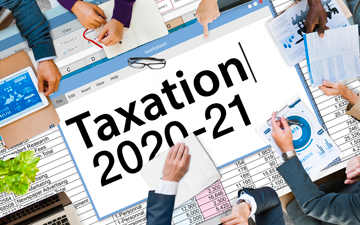Canadian tax laws: A review of 2020 and a look ahead to 2021

A comprehensive review of Canadian tax developments in 2020 and outlook for 2021 from experts at Davies Ward Phillips & Vineberg LLP in Montreal and Toronto
Review of Canadian Tax Developments in 2020
The year 2020 was anything but normal with the global COVID-19 pandemic creating both human and fiscal challenges in Canada and abroad. The federal government’s attention was fixed firmly on the pandemic for most of the year, and it was only in November that tax legislation was released that did not respond directly to the crisis. Although this legislation contained a significant new revenue-raising measure, in the form of changes to the GST/HST rules as they relate to cross-border e-commerce, it remains to be seen how the government will deal with a projected record deficit of over $381 billion for 2020-21.
Tax Legislation
In an otherwise eventful year, 2020 was a quiet one for tax legislation. Typically, the federal government tables an annual budget in the spring of each year, which is generally followed by the provincial budgets. The timing for this year coincided with the beginning of the COVID-19 pandemic. Hence, although the provinces issued their budgets, the federal government deferred its own budget to focus on Canada’s response to the pandemic. This response included a raft of legislation aimed at supporting businesses and individuals, such as a wage subsidy for employers in the form of the Canada Emergency Wage Subsidy (CEWS); direct payments to eligible individuals and workers under the Canada Emergency Response Benefit (CERB) and Canada Recovery Benefit (CRB); interest-free, partially forgivable loans to small businesses and not-for-profits through the Canada Emergency Business Account (CEBA); and commercial rent relief under the Canada Emergency Commercial Rent Assistance (CECRA) and later the Canada Emergency Rent Subsidy (CERS). The government has estimated the total cost of the COVID-19 response, in the form of direct fiscal and health measures, deferred revenue and accelerated spending, at approximately $407 billion, nearly 19% of GDP.
It was not until November 30, 2020, that the federal government released a mini budget in the guise of the Fall Economic Statement. This provided details of the extension into 2021 of COVID-19 relief legislation, including the CEWS. A small number of tax changes were also proposed, such as the previously announced changes to the taxation of employee stock options, along with new sales tax provisions directed at the digital economy.
Federal corporate and personal tax rates remained unchanged. On the provincial side, in 2019 Alberta adopted corporate tax cuts that will see the general corporate rate drop to 8% starting in 2022 (it is 9% for 2021). In its 2020 provincial budget, Québec announced that effective in 2021 it will reduce its corporate tax rate to 2% (from currently 11.5%) on patent royalties and on up to 75% of profits from certain other forms of specified IP-related income, provided that the relevant taxpayer has carried out scientific research and experimental development (SR&ED) in Québec and the IP being commercialized results in whole or in part from SR&ED carried out in Québec.
Taxation of Employee Stock Options
The Fall Economic Statement updated the previously announced changes to the taxation of employee stock options, which are to be effective for certain options granted on or after July 1, 2021. Under the existing rules, employees of corporations and mutual fund trusts who are issued stock options are able to access preferential personal income tax treatment (50% of ordinary tax rates) in the form of a deduction for qualifying stock option benefits (Option Deduction), which replicates the capital gains’ rate.
The proposed rules limit the availability of the Option Deduction for options with the same vesting year to the extent that the fair market value of the securities under the options exceeds $200,000 at the time the options are granted. If the vesting year is unclear on the date of the grant, the option will be deemed to vest on a pro rata basis over the term of the option agreement up to a maximum of five years. The Fall Economic Statement proposals also limit the charitable deduction available in respect of stock options to the same extent as the Option Deduction, so that an employee can benefit only from the charitable deduction on $200,000 of securities.
Options granted by Canadian-controlled private corporations (CCPCs) and non-CCPCs whose annual gross revenue does not exceed $500 million will not be subject to the Option Deduction limitations.
The proposals allow employers to claim a deduction in respect of the stock option benefits included in their employee’s income to the extent that the employees are not entitled to an Option Deduction because of the $200,000 limit.
Sales Tax Changes Relating to the Digital Economy
The Fall Economic Statement proposed detailed changes to the sales tax rules relating to e-commerce transactions, effective July 1, 2021. The proposals are aimed particularly at digital sales and websites advertising short-term accommodation.
- Cross-Border Digital Products and Services. The proposed rules provide that non-resident vendors that have no physical presence in Canada and sell digital products or services to Canadian consumers would be required to register for GST/HST and collect and remit tax on taxable sales to Canadian consumers. Registration, collection and remittance of GST/HST is currently not required by these vendors. A simplified GST/HST regime would apply for these entities.
- Online Marketplaces and Fulfillment Warehouses. Distribution platform operators (and non-resident vendors that do not sell through a distribution platform) would be required to collect and remit GST/HST on sales to Canadian purchasers by non-registered vendors of goods shipped from a fulfillment warehouse or other location in Canada. In addition, distribution platform operators and fulfillment warehouses would be required to provide certain information to the Canada Revenue Agency (CRA) and maintain records relating to their non-resident clients.
- Short-Term Rental Accommodation. GST/HST would apply to all platform-based short-term rental accommodation supplied in Canada. The burden of collecting and remitting GST/HST would fall on either the property owner, if registered for GST/HST, or the digital accommodation platform if the owner is not registered. A simplified GST/HST regime would be available for non-resident accommodation platform operators that are not carrying on business in Canada.
Canada Emergency Wage Subsidy
The CEWS, which was introduced in April 2020 in response to the pandemic, provides a subsidy to qualifying employers for wages paid to employees. When first introduced, it was scheduled to run for the 12-week period from March 15 to June 6, and it provided a subsidy of up to 75% of wages for employers that suffered a 70% drop in revenue relative to the comparable period pre-pandemic. Over the course of the year the program was extended and modified, applying more broadly and at different rates, depending on the extent of an employers’ revenue reduction. A detailed discussion of the CEWS can be found in our bulletin.
The Fall Economic Statement further extended the CEWS to June 2021. For the period commencing December 20, 2020, and ending March 13, 2021, a subsidy of up to 65% of eligible wages is available to all eligible employers that experience a decline in revenue, with a base subsidy of up to 40% of eligible wages and an additional top-up subsidy of up to 35% for employers that experience a decline in revenue of 70% or more.
Details of the wage subsidy for any period beyond March 13, 2021, are to be provided at a later date.
Tax Administration
Temporarily Extended Deadlines Under the Income Tax Act and Excise Tax Act
On August 31, 2020, the Minister of National Revenue issued orders extending various periods under the Income Tax Act (ITA) and the Excise Tax Act (ETA) by virtue of new powers granted to the Minister under the Time Limits and Other Periods Act (COVID-19) (Time Limits Act), which received royal assent on July 27, 2020.
Statute-Barring Periods
Under the ministerial orders, the period within which the CRA can issue reassessments was extended by six months or until December 31, 2020, whichever is earlier, in respect of years or periods that would otherwise have become statute-barred under the ITA or ETA on or after May 20, 2020. These ministerial orders are no longer in force and no further extensions have been announced.
Relief for Late-Filed Notices of Objection
The one-year time limit for making late-filed objection requests was also extended. Time limits for making relief requests that otherwise would have expired between March 13 and September 13, 2020 were extended by the earlier of six months of the normal relief request deadline and December 31, 2020. The same extension was also applied to the time within which a taxpayer or registrant may contest, before the Tax Court of Canada, a refusal by the Minister to grant such an extension. Again, no further extensions have been announced.
Canada’s Response to International Tax Issues Raised by COVID-19
On May 19, 2020, the CRA issued Guidance on International Income Tax Issues Raised by the COVID-19 Crisis (Guidance), in which it outlined potential Canadian income tax issues resulting from pandemic-related travel restrictions, as well as its proposed response to address such issues.
Income Tax Residency: Individuals and Corporations
With respect to the common law test of tax residency, the Guidance provided that individuals will not be considered tax residents of Canada solely by virtue of the fact that they remained physically present in Canada as a result of COVID-19-related travel restrictions. Similarly, in computing the 183-day threshold for deemed tax residency, the CRA confirmed that it would not take into account days during which the individual was present in Canada and unable to return to his or her country of residence solely as a result of travel restrictions.
For corporations resident in treaty countries, dual corporate residency is typically resolved by applying a residency “tie-breaker rule” that looks to, inter alia, the corporation’s place of effective management. According to the Guidance, such corporations were not to be considered resident in Canada solely because a director participated in a board meeting from Canada due to COVID-19 travel restrictions. However, corporate residency determinations involving potential dual residents of non-treaty countries will be determined on a case-by-case basis.
These administrative concessions were applicable for the period between March 16 and September 30, 2020. It is unclear whether they will be renewed if travel restrictions are tightened again in response to the second wave of COVID-19.
Carrying on Business and Permanent Establishments
Residents of treaty countries are subject to tax in Canada on their business income only if their business activities are carried on through a permanent establishment (PE) situated in Canada. The Guidance provided that, for the period between March 16 and September 30, 2020, a non-resident entity will not be considered to have a PE in Canada solely because its employees were required to perform their employment duties in Canada as a result of travel restrictions. The Guidance also provides similar relief in circumstances in which, due to travel restrictions, the non-resident entity could be viewed as having either an “agency” PE or a “services” PE (e.g., Articles V(5) and V(9)(a) of the Canada-U.S. tax treaty). In the case of residents of non-treaty countries, the CRA stated that it would decide on a case-by-case basis whether any administrative relief would be appropriate.
Cross-Border Employment
The Canada-U.S. tax treaty provides (in Article XV(2)) a limited safe harbour for U.S. resident persons employed in Canada, exempting them from Canadian tax on their Canadian source employment income if the income does not exceed $10,000 or they are not present in Canada for more than 183 days in a 12-month period and the income is not borne by a PE. As a result of the COVID-19-related travel restrictions, certain U.S. employees that regularly perform employment duties in Canada may have been required to remain physically present in Canada beyond the 183-day limit. The Guidance confirmed that the days during which such individuals were physically present in Canada because of travel restrictions will not be taken into account in computing the 183-day period. Similar administrative measures would also apply in computing the days of presence test in respect of employees ordinarily resident in other treaty countries.
Similarly, non-resident employers with Canadian resident employees are required to deduct withholdings at source, regardless of where the employment services are being rendered. However, such withholdings can be reduced by obtaining a “letter of authority” (LOA) from the CRA, which will take into account any foreign taxes payable by the Canadian employee. In the event that such Canadian resident employees – having previously obtained a LOA for 2020 – performed their employment duties from Canada as a result of travel restrictions, they would nevertheless continue to benefit from the reduced Canadian withholdings at source outlined in the LOA.
Lastly, the Guidance also provided that the CRA will not assess or penalize a non-resident employer for failing to withhold the required Canadian payroll deductions during 2020. Certain criteria need to be satisfied to benefit from this measure, including demonstrating that the employee is not ordinarily resident in Canada and that his or her remuneration would otherwise be exempt from taxation in Canada under a tax treaty. It should be noted that, unlike the other measures outlined in the Guidance, this administrative concession potentially applied through December 31, 2020.
Tax Cases
Decision on Derivatives by Supreme Court in MacDonald
The Supreme Court of Canada (SCC) has upheld the Federal Court of Appeal (FCA) decision in MacDonald v The Queen, concerning whether a derivative contract entered into by the taxpayer was a hedge on capital account or, alternatively, a speculative investment on income account.
The taxpayer owned a large number of Bank of Nova Scotia (BNS) shares, which he held on capital account. He obtained a credit facility from the Toronto-Dominion Bank, for which he was required to pledge the BNS shares as partial security and enter into a cash-settled forward contract relating to a large number of BNS shares. If the BNS share price increased, the forward contract would decline in value; if the price decreased, the contract would increase in value. As it turned out the BNS share price increased, the taxpayer settled the contract over time, and he suffered a loss. The taxpayer took the position that the loss was on income account, on the grounds that his intention was to use the forward contract for speculation, not to hedge risk.
The SCC disagreed, holding that the forward contract was a hedge and, since the BNS shares were held on capital account, the loss was a capital loss. In coming to this conclusion, the Court acknowledged that a taxpayer’s stated intentions are relevant to the determination of whether a derivative contract is a hedge, but emphasized that objective evidence of a taxpayer’s intentions is generally more persuasive. With regard to hedging, the primary evidence of the purpose of a derivative contract is the degree to which the contract mitigates the attendant economic risks of the asset, liability or transaction that it purportedly hedges. The more effective a derivative contract is at mitigating or neutralizing such economic risks, the stronger the inference that the purpose of the contract is to hedge those risks.
In concluding that the forward contract acquired by Mr. MacDonald was a hedge, the SCC took into account two related facts: the contract almost perfectly neutralized fluctuations in the price of the BNS shares and, from the perspective of the Toronto-Dominion Bank, this meant that the value of the collateral for the loan was protected from market fluctuations. The fact that he did not sell his BNS shares to offset the losses did not, in the opinion of the SCC, sever the linkage between the contract and the underlying shares.
In ascertaining whether a taxpayer intends to use a derivative contract to hedge an underlying asset, liability or transaction, the decision of the SCC in MacDonald represents a significant shift in the weight given to the extent to which the contract mitigates or neutralizes economic risks inherent in the asset, liability or transaction. The SCC decision held that the evidentiary burden regarding establishing a taxpayer’s intention is primarily determined by the objective factors indicating whether the derivative contract substantially mitigates the economic risks of an underlying asset, liability or transaction, even if those risks are ones that the taxpayer was not intending to hedge. In a lengthy dissent, Justice Côté raised concerns that this shift will introduce uncertainty into the tax treatment of derivative contracts. It remains to be seen how the CRA will apply the principles set out in the majority decision.
Tax Treaty Benefits Upheld in Alta Energy
The FCA rendered its judgment in Alta Energy Luxembourg SARL v The Queen, affirming the decision of the Tax Court of Canada (TCC) that treaty benefits claimed by a Luxembourg special purpose company on the sale of shares of a Canadian oil and gas company were not abusive treaty-shopping under Canada’s domestic general anti-avoidance rule. Alta Energy was decided just as Canada formally embarked on a new era of international coordination under the OECD’s Multilateral Convention to Implement Tax Treaty Related Measures to Prevent Base Erosion and Profit Shifting (MLI), which became effective for Canada’s tax treaties with many other ratifying countries for withholding taxes on January 1, 2020, and for other taxes (including capital gains taxes) for tax years beginning on or after June 1, 2020. The SCC has granted leave to appeal from the judgment of the FCA.
Transfer Pricing Recharacterization Rejected in Cameco
The FCA rendered its judgment in the Cameco Corporation v Canada transfer pricing case, affirming the decision of the TCC in favour of the taxpayer. Cameco is a large producer and supplier of uranium, which is bought and sold in an unregulated market under bilateral contracts but is not traded on a commodity exchange. The taxpayer had entered into long-term contracts with its European subsidiary for the purchase and sale of uranium based on fixed prices. Owing to ensuing market price increases, the subsidiary earned substantial profits.
The case concerns the interpretation of the recharacterization rule in Canada’s transfer pricing legislation. Before the FCA, the Crown argued that the Minister could book the profits of the European subsidiary in Cameco’s hands, because Cameco would not have entered into the transactions that it did with an arm’s length person. In rejecting this submission, Webb JA observed that the relevant test under the transfer pricing rules is whether the transaction would have been entered into between persons dealing with each other at arm's length (an objective test based on hypothetical persons) and not whether the particular taxpayer would have entered into the transaction with an arm’s length party (a subjective test).
The FCA recognized the extraordinary nature of the transfer pricing recharacterization rule and held that it does not allow the Minister to simply reallocate all of the profit of a foreign subsidiary to its Canadian parent company on the basis that the Canadian corporation would not have entered any transactions with its foreign subsidiary if they had been dealing with each other at arm's length. The Crown has sought leave from the SCC to appeal the decision of the FCA.
Transfer Pricing for Cross-Border Services Affirmed in Agra City
The judgment of the TCC in AgraCity Ltd. v The Queen represents another loss for the Minister in its increasingly aggressive challenges to transfer pricing arrangements. The taxpayer, a Saskatchewan-based corporation, was a member of an agricultural buying group that supplied agriproducts to Canadian farmers. The group incorporated a subsidiary in Delaware to purchase a glyphosate-based herbicide manufactured in the United States from third-party U.S. suppliers for resale to Canadian farmers. Although the herbicide was not registered for sale in Canada, it could be imported into Canada under a special program established by the federal government to permit Canadian farmers to purchase designated herbicides for personal use from non-Canadian sources. Note, as discussed further below, that the non-Canadian suppliers (initially the Delaware subsidiary) were prohibited from offering, in Canada, the herbicide to the farmers who had to reach out, in the United States, to the suppliers. Much of this import and resale business was subsequently transferred to a newly incorporated Barbados subsidiary in order to reduce U.S. taxes paid on the profits from sales to Canadian farmers. During the years at issue, the taxpayer provided logistics services to both the Delaware and the Barbados companies in return for service fees.
The Minister challenged the services relationship between the taxpayer and the Barbados subsidiary on the basis that it was a sham intended to conceal the fact that all income-earning activities were instead performed by the taxpayer. In the alternative, the Minister reassessed the appellant under the transfer pricing rules in the ITA on the basis that all of the profits of the Barbados subsidiary from its sales to Canadian farmers should be reallocated to the taxpayer.
The TCC rejected all of the Minister’s arguments. With respect to the Minister’s sham theory, the evidence clearly established that the taxpayer had not deceitfully misrepresented the rights and obligations of the parties and that the business of importing and reselling the herbicide to Canadian farmers was indeed conducted by the Barbados subsidiary, with the taxpayer providing only ancillary services. The Court accorded particular significance to the fact that the regulatory regime for importing the herbicide into Canada made a foreign subsidiary structure, in some form, essential to the business because it was illegal for anyone to offer the herbicide for sale in Canada or to sell it in Canada. Further, the Court held that the transactions at issue between the taxpayer and the Barbados subsidiary were commercially rational in light of the functions performed by each party and accepted the expert evidence that the fees charged by the taxpayer for its services were within the arm’s length range of prices. The Minister has not appealed the decision to the FCA.
Offshore Bank Structure Affirmed in Loblaw
The FCA decision in Loblaw Financial Holdings v The Queen concerned whether a Barbados subsidiary in the Loblaw group, Glenhuron Bank Limited (GBL), carried on an “investment business” for purposes of the “foreign affiliate” rules. The TCC had concluded that it did, on which basis the income of GBL was “foreign accrual property income” (FAPI), and as such was required to be included in the income of the Canadian parent corporation on an accrual basis. The case turned on the interpretation of the regulated foreign bank exception, which provides that a business carried on by a regulated foreign bank is not an investment business if certain conditions are met. Although changes were made to the regulated foreign bank exception, effective 2015, that would have denied GBL access to the exception had the changes applied in the years at issue, the decision in Loblaw remains relevant for a number of reasons.
GBL engaged in various financing activities, which were funded with a combination of capital received from members of the Loblaw group of companies and retained earnings. The sole question before the FCA was whether the TCC erred in concluding that GBL did not conduct business principally with arm’s length persons for purposes of the investment business definition. The TCC had based its conclusion on the fact that GBL had received its financing from non-arm’s length persons. Since, in its view, the business activities of a bank extend to both the receipt and the use of funds, the non-arm’s length nature of these receipts should be taken into account. In addition, while substantially all of the investments made by GBL were with arm’s length persons, the TCC framed GBL’s activities in terms that suggested GBL was carrying on business for its parent company and not for its own account.
The FCA rejected both of these positions. On the matter of the nature of a banking business, the FCA held that there was no basis to conclude that the arm’s length test requires looking to both the receipt and the use of funds and that, on the particular facts in the case, the capital investments received from other Loblaw entities were not part of the business conducted by GBL. This conclusion is in line with the long-standing distinction between the capital that allows a person to conduct its business and the activities by which it earns its income. On the second point, the FCA held that the TCC had failed to respect the distinction between a corporation and its shareholders when it determined that GBL was acting on behalf of its parent in the course of its business activities. While the parent may have provided direction and oversight, this did not mean that GBL carried on business either with or for its parent.
The FCA therefore concluded that GBL carried on its business with arm’s length persons and that its income was therefore not FAPI. In October 2020, however, the SCC granted the Crown’s leave to appeal.
Canadian Tax Development Outlook for 2021
Tax Legislation
The absence of a federal budget in 2020 has raised expectations for the 2021 budget, which, it is hoped, will see Canada out of the COVID-19 pandemic. The upcoming budget will most likely continue the government’s policy of massive stimulus to help Canada emerge from the economic consequences of the pandemic. The budget may also see some revenue-raising measures to address the government’s ballooning deficit.
Building Back Better
The Fall Economic Statement set out an investment plan for Canada’s recovery based on post-pandemic stimulus spending of $70 to $100 billion over three years. In its September 23, 2020, Speech from the Throne, the federal government made commitments to “build back better to create a stronger, more resilient Canada” to address the existential threat of climate change. For now, the particulars of how the government intends to usher in this promised green recovery are still unknown, but it is likely that fiscal policy will be a key driver of these initiatives.
[Editor's note: Click on the following link to download the related article, "Is a Green New (Tax) Deal Coming to Canada?" originally published in Tax Notes International, by Davies lawyers Gregg Benson, Michael Kandev and James Trougakos.]
The ITA currently contains four tax incentives specifically designed to promote investment in “green” energy generation projects:
- an accelerated capital cost allowance rate for specified clean energy generation equipment;
- an immediate deduction for certain expenses incurred in the development of clean energy or “green energy” generation projects;
- a flow-through share mechanism by which principal-business corporations may renounce certain expenditures to their shareholders, allowing such shareholders to shelter other sources of income; and
- the 10% Atlantic investment tax credit, which applies to the capital cost of certain prescribed energy generation and conservation properties.
Possible upgrades to these measures that could come in the 2021 federal budget might include the following:
- First, the accelerated capital cost allowance is currently useful only to renewable energy businesses that are already profitable; moreover, its availability is limited to the income from renewable energy properties or from a business selling the product of such properties. One way to expand this incentive would be to make it generally deductible against other sources of income, including through a partnership. This would be consistent with the U.S. tax policy of allowing flip partnership structures.
- Second, the Canadian renewable and conservation expense deduction, which is effectively an extension of the Canadian exploration expense system for oil and gas, could be expanded in scope in line with deductions available to the oil and gas sector. This would also increase the potential for flow-through share financing deals of renewable energy companies.
- Third, the 10% Atlantic investment tax credit for renewable energy could possibly be extended to the rest of the country or transferred into a new category of investment tax credit for renewable energy.
Possible Revenue-Raising Measures
Much ink has been spilled over the past several months speculating on how and when the government will start to raise revenue to fund the extraordinary costs of the pandemic response. The changes to the GST/HST rules for e-commerce transactions, estimated to bring in around $3 billion over five years, will be part of this, but these changes have been in the works for some time. While we have no more insight into this than anyone else, we see two broad categories of possible revenue-raising measures: targeting wealthy Canadians and taxing foreign multinationals.
The government’s prior initiatives to tax the wealthy, including the most recent stock option changes described above, have fuelled consistent rumours that the government may scale back the favoured tax treatment of capital gains by increasing the current 50% inclusion rate. Other possible changes, which have been canvassed in the media, include the adoption of an estate or an inheritance tax on large successions. However, as the current minority Liberal government might be expected to trigger an election later in 2021 in the hopes of capitalizing on its pandemic management performance, it seems unlikely that any substantial revenue-raising personal tax measures that would upset a section of the electorate will be proposed.
A more likely approach for this government is to enact corporate tax increases on foreign multinationals. Canada has been working within the OECD/G20 Inclusive Framework on Base Erosion and Profit Shifting (BEPS) with a view to developing a coordinated approach to the tax challenges arising from digitalization by mid-2021. While the government has committed to a multilateral solution, it has expressed concern about the delay in arriving at a consensus. Accordingly, in the Fall Economic Statement the government proposed implementing a tax on corporations providing digital services, starting on January 1, 2022. The Fall Economic Statement did not provide details on the exact measures the federal government will pursue, but it appears to be considering a digital services tax (DST), similar to the one adopted by France, consistent with prior statements made by the governing Liberal Party as part of its re-election platform. On a provisional basis, the government estimates that the new measure would increase federal revenues by $3.4 billion over five years. Considering that this month France started raising its digital services tax and the United States announced it would not immediately retaliate (by imposing tariffs on French luxury goods), the way may be clear for a Canadian DST. Finally, Canadian-based multinationals will be keeping a close eye on the OECD-led discussions now taking place (noted in the accompanying bulletin on U.S. tax laws) regarding a potential “minimum tax” (under the so-called Pillar 2 mechanics) on foreign subsidiary profits and whether the views of those who oppose the notion gain traction.
Tax Administration
What is highly likely is that in 2021 and beyond, the CRA will be under much increased pressure to bring in needed funds to service Canada’s public debt. In the Fall Economic Statement, the government promised to provide additional funding by committing an additional $606 million over five years to enable the CRA to target offshore tax compliance, commencing in 2021-22. The Fall Economic Statement also indicated that the government would be launching a consultation in early 2021 on potential amendments to Canada’s anti-avoidance rules, including the general anti-avoidance rule. All of this will likely result in more aggressive audits and more frequent assessments in cross-border situations.
Tax Cases
Two high-profile tax cases will be heard and possibly decided by the SCC in 2021: Loblaw and Alta Energy. The narrow issues in Loblaw are only of historical relevance because the availability of the offshore bank structure at issue in that case has been substantially legislatively curtailed since 2015; however, the fundamental issues relating to the interpretation of the scope and purpose of Canada’s foreign affiliate and foreign accrual property income regime (equivalent to the U.S. Internal Revenue Code Subpart F provisions) could have far reaching consequences.
The SCC’s consideration of Alta Energy is also eagerly awaited. If upheld, both the SCC decision and the unanimous decision of the FCA in favour of the taxpayer may have dual significance: on the one hand, it may dampen the Canadian government’s confidence in the application of the general anti-avoidance rule to defeat treaty benefit claims it regards as abusive; and on the other hand, it should provide guidance on how the principal purpose test that is the centrepiece of the MLI should be applied to perceived treaty-shopping cases.
Michael N. Kandev and Paul Lamarre are partners at Davies Ward Phillips & Vineberg LLP (Davies) in Montreal and Toronto respectively. Reuben Abitbol, James Trougakos, Jesse A. Boretsky are associates in the Montreal office of Davies. Cadie Yiu is an associate in the Toronto office of Davies.
Download the related article, "Is a Green New (Tax) Deal Coming to Canada?" originally published in Tax Notes International, by Davies lawyers Gregg Benson, Michael Kandev and James Trougakos.










(0) Comments